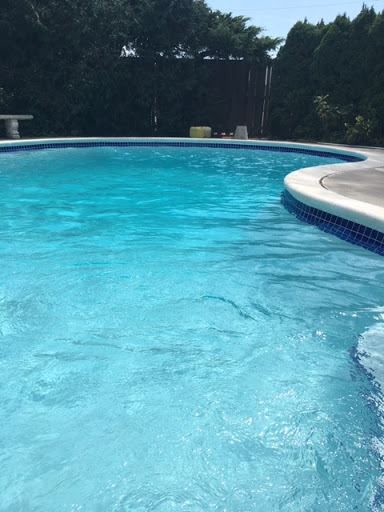Once upon a time, there was a lovely pool in Humphrey's garden. It was built in 1974, and fashioned from gunnite and marbelite. The gunnite concrete was 2 feet think! He often wondered if Jimmy Hoffa lived there.
Sometimes, Humph swam at night.
But, as the years went by, the marbelite surface wore down and it needed renovation. In the 1990s, only one company in the entire county repaired concrete pools! The only surface they offered was a fibreglass polymer paint called Inter-Glass, but it seemed like a good idea with its lifetime warranty.
Next thing you know, the company (which was subcontracted by a legitimate pool company in the area) went belly up and nobody would honour the warranty. A lot of townspeople found themselves in the same situation. The fibreglass polymer was popping off the gunite! People had big gaps at their tile line. The coping stones moved around, and there were gaps everywhere. In placed (such as on the steps) the fibreglass popped off altogether! A guy named Larry went from pool to pool, and bolted the fibreglass to the gunite, and then caulking the gap. It looked awful, and the bolts on everyone's pools eventually rusted. But there was nobody to repair the surface, let alone Larry's repairs!
Even though the pool was a problem, it was mostly functional. Humphrey continued to do his Dog Science Lab experiments that involved gravity and "sinks or floats" hypotheses. Spoiler: the rubber frog floats, but the solid Gumby toy sinks.
Humphrey searched tirelessly for two years, and finally found some retired pool experts to restore the pool to its glory! The experts happened to be the ORIGINAL installers from 1974! They ranged in age between 70 and 90, and were the most charming group of Paisan's Humphrey ever met.
The experts did not which to do demo, so Humphrey had to hire different contractors - not an easy task for a messy job. Larry came to the rescue (sort of) to remove the fibreglass so that the experts could do their thing. The demo was a huge challenge, because the fibreglass was stubborn. Humphrey called pool experts in Illinois and Florida to get advice to pass on to Larry. In the end, they used a combination of blowtorch, angle grinding by hand, and sandblasting.
The demo took about two weeks. Next, the Paisan's came around. They did some little repairs to the pool mechanics.
The first task was to remove and re-set the coping stones. Coping is the material to cap the pool's edge (in this case, it was two-foot stones) to seal the side of a concrete pool, prevent splashing out, and to direct the water that does splash out away from the pool. The original, 1974 coping stones remained in good shape, so they were removed and re-set with cement. These shots show the coping removed from the edge, and scaffolding that was set up in the deep end.
Quite surprisingly, only one section of pipe needed to be replaced, so the contractors removed a section of cement deck, dug out the section of pipe, replaced it, and repaired the concrete.
Next, they removed the old, turquoise mosaic tiles, and replaced with larger (2 by 2), dark blue tiles:
Once the coping was set, and the tiles were set and grouted, the new surface came on in two stages over three work days.
First, the workers applied a scratch coat of plaster on the entire surface. The scratch coat cured for 3 days, then the
marbelite surface (a composite of cement, white sand, and marble that is especially durable) was applied. Marbelite is a little more expensive than other pool plasters, but when applied correctly and cared for will last about 30 years. Next, a crew of two applied the marbelit to the steps, and let it dry overnight. Finally, a crew of 7 worked one day to apply marbelite to the entire surface in one day. Everyone had a task, and they were efficient and precise.
Twenty-four hours later, a truck arrived with 15,000 gallons of water! To figure out how much Humphrey needed to order, he multipled the pool dimensions (30x15) times a factor of 7 for the kidney shape.
Some chemicals went into the pool, and it was ready for swimming (though cold!) that day!
Soon, the water will warm up, Humphrey will update the landscaping with lots of peegee hydrangeas, and he'll be running to the pool like he used to:
















